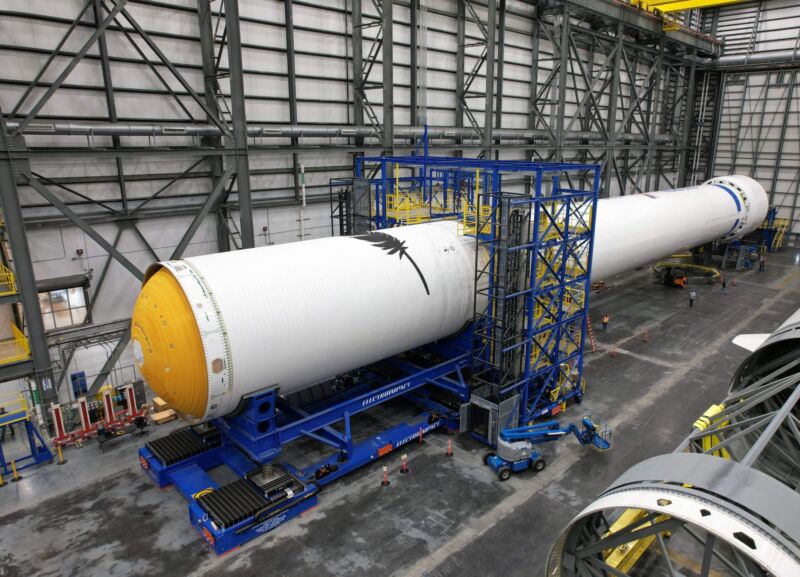
Enlarge / First and second stages of Blue Origin’s “New Glenn” test vehicle.
Blue Origin
Welcome to Edition 6.28 of the Rocket Report! There’s a lot going on in the world of launch as always, but this week I want to take this space for a personal message. I have just announced the forthcoming publication of my second book, REENTRY, on the Falcon 9 rocket, Dragon spacecraft, and development of reusable launch. Full details here. I worked very hard to get the inside story.
As always, we welcome reader submissions, and if you don’t want to miss an issue, please subscribe using the box below (the form will not appear on AMP-enabled versions of the site). Each report will include information on small-, medium-, and heavy-lift rockets as well as a quick look ahead at the next three launches on the calendar.

Europe seeks to support small launch companies. The European Space Agency and European Commission have selected five launch companies to participate in a new program to provide flight opportunities for new technologies, a sign of a greater role the European Union intends to play in launch, Space News reports. The effort seeks to stimulate demand for European launch services by allowing companies to compete for missions in the European Union’s In-Orbit Demonstration and Validation technology program. Proposals for the program’s first phase are due to ESA at the end of February.
Getting a golden ticket … The agency expects to select up to three companies for initial contracts with a combined value of 75 million euros ($82 million) to begin design work on those vehicles. Four of the companies selected for the “Flight Ticket Initiative” are startups working on small launch vehicles: Isar Aerospace, Orbex, PLD Space, and Rocket Factory Augsburg. None of them has yet conducted an orbital launch, but they expect to do so within the next two years. The fifth company was Arianespace, which will offer rideshare launches on its Vega C and Ariane 6 rockets. (submitted by Ken the Bin and EllPeaTea)
Iran successfully launches Qaem 100 rocket. Iran said Saturday it had conducted a successful satellite launch into its highest orbit yet, the latest for a program the West fears improves Tehran’s ballistic missiles, the Associated Press reports. The Iranian Soraya satellite was placed in an orbit at some 750 kilometers (460 miles) above the Earth’s surface with its three-stage Qaem 100 rocket, the state-run IRNA news agency said. It did not immediately acknowledge what the satellite did, though telecommunications minister Isa Zarepour described the launch as having a 50-kilogram (110-pound) payload.
Qaem’s first orbital flight … The United States has previously said Iran’s satellite launches defy a UN Security Council resolution and called on Tehran to undertake no activity involving ballistic missiles capable of delivering nuclear weapons. UN sanctions related to Iran’s ballistic missile program expired last October. Iran has always denied seeking nuclear weapons and says its space program, like its nuclear activities, is for purely civilian purposes. This was the third launch of the Qaem rocket, which can loft up to 80 kg to low-Earth orbit. A suborbital test flight in 2022 was successful, but the first orbital attempt last March failed. (submitted by Ken the Bin)
The easiest way to keep up with Eric Berger’s space reporting is to sign up for his newsletter, we’ll collect his stories in your inbox.
Chinese firm tests vertical landing. Chinese launch startup Landspace executed a first vertical takeoff and vertical landing with a test article Friday at a launch and recovery site at Jiuquan spaceport, Space News reports. The methane-liquid oxygen test article reached an altitude of around 350 meters during its roughly 60-second flight before setting down in a designated landing area. The landing had an accuracy of about 2.4 meters and a landing speed of less than 1 meter per second, the company said.
Part Starship, part Falcon 9 … The test is part of the development of the stainless-steel Zhuque-3 rocket first announced in November 2023. The company is aiming for the first flight of Zhuque-3 next year. It is an ambitious project: The rocket is intended to have a payload capacity of 21 tons to low-Earth orbit in expendable mode, and 18.3 tons when the rocket is recovered downrange. If Zhuque-3 comes to pass—and these are promising early results—this would be the closest thing to a Falcon 9 rocket anyone has yet developed. (submitted by Ken the Bin)